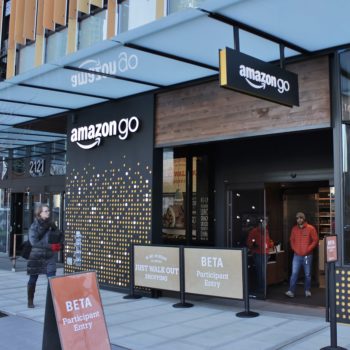Amazown Goal? Shining a Light on the Inconvenient Impact of Convenience
by Hugh Williams on 6th Feb 2018 in News

January 2018 may go down in history as the month when automation went mainstream. Here, Dr John Bates, CEO, Testplant, tells us exclusively how, despite decades of premonitions, promises, and potential, when Amazon Go opened the doors of its first store, expectation became reality.
Ignoring numerous delays, its high-tech version of a convenience shop with no checkouts, cashiers, or waiting, launched to a fanfare of ‘store of the future’ headlines. The bricks-and-mortar concept allows customers to grab items and leave without stopping to pay. All you need is an Amazon account and the app. The sensor-packed store does the rest, spotting your every move and purchase, totalling the bill and then debiting your account.
But, for all the headlines, by creating a traditional shop, Amazon has highlighted areas that could be considered something of an own-goal for the brand – even in the short term. The ‘test thefts’ have been well documented and, while cited as ‘not a problem’, would certainly be an issue for a concept with ambitions of scaling.
Similarly, for all Amazon’s vision, it doesn't actually win the 'how fast can I shop' race – online grocery shopping delivered to your door does that. Some commentators even suggested that it worked so well there was nothing remarkable about it. After all, once the initial awe has abated, it is an ordinary shop with a novelty value that will wear off like the first time you could unlock your phone with your thumb. So, looking beyond the brilliance of the idea, what are the inconveniences behind the world's most innovative convenience store?
Where are the recommendations?
The ‘you may also like…’ function was arguably one of the biggest USPs that helped propel the early days of the company, using AI to drive connected, but impulse, purchases. Of course, this has been lost in the real world. While it seems like a big miss, it’s one we’d expect to see Amazon resolve if the concept is to scale. The data Amazon will get will be enormously valuable on multiple levels and help inform the company’s online grocery business, and probably Whole Foods too. We’ll see offline-to-online retargeting – where data from social media or loyalty cards provides product suggestions in real time while a customer is browsing. However, the company has yet to speak about that or how it will use the data and shopping histories captured from in-store shoppers.
Don't you care about the people?
It’s also likely that this new technology could eliminate low-wage, low-skill jobs – arguably the biggest criticism of the Amazon Go concept. However, the economical position is that jobs lost will be replaced with high-wage, high-skilled roles elsewhere and that the transition is good (for the economy) in the long run. In the case of Amazon’s technology, a store might need fewer cashiers but more engineers and developers. As fate would have it, only days after the ‘death of the shop assistant’ was being heralded, Amazon announced the opening of a new distribution centre creating 400 jobs in HR and IT. It’s not a direct cause and effect, but it demonstrates the point in real time.
Can you actually scan everything?
Artificial intelligence and machine learning technology have come on leaps and bounds, but testing and accounting for nuances will be critical if Amazon Go is to expand globally. Right now, it is limited by the state of computer vision, although that will change. Things like loose fruits and vegetables of different sizes, deformable items such as large packets of crisps or objects that change colour, like a banana, will all need to be accounted for. Testing, spotting, and being able to manage the minutiae will not only become critical, but will require Amazon to continue to push the boundaries of today’s technology. Of course, there is a simpler solution in the form of coding and additional packaging, although given growing environmental awareness, this would create another issue for a businesses with aspirations of becoming the world's biggest retailer.
Can it scale?
Amazon’s technology may prove expensive to deploy and difficult to manage. It may be that its arrival is akin to the 1980s hovercraft: exciting, revolutionary but, ultimately, too much trouble to keep up in a low-margin business like convenience shops. Only a select few people know if the system behind Amazon Go can be deployed at competitive cost and at scale, like an iPhone, or if it is an expensive, one-off display of innovation.
However, what can't be denied is that Amazon Go is best suited to busy small-to-medium stores where everything is pre-packaged and users buy a few items at a time. Here, the speed of the transaction is important and the range of products can be relatively linear. It suits a mass market of technologically engaged people in a rush, and who feel like they can get a few things they need immediately without ever needing to stop. Now, where can I find some of those?This content was originally published in RetailTechNews.
AmazonecommerceIn-storePayment







Follow ExchangeWire